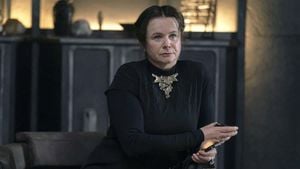Bela Karolyi, the celebrated but controversial gymnastics coach, has passed away at the age of 82. His death, which was confirmed by USA Gymnastics, marks the end of an era for the sport he helped shape. A hallmark of American gymnastics for over three decades, Karolyi’s legacy is intricately tied to both the glory of Olympic success and the shadows of scandal.
Karolyi, alongside his wife Martha, made dramatic contributions to gymnastics, nurturing prodigious talents like Nadia Comaneci, who first scored the elusive perfect 10 at the 1976 Olympics, and Mary Lou Retton, the first American woman to win the all-around Olympic gold medal at the 1984 Games. “A big impact and influence on my life,” Comaneci posted on Instagram, reflecting on their relationship.
Born on September 13, 1942, in Cluj, Romania, Karolyi had aspirations to be a teacher. It was only during his university years, yearning for companionship with Martha, he stumbled upon coaching. The couple's early foray was modest, teaching gymnastics to local children to keep them warm and entertained during harsh winters. Their breakthrough came when they were recruited to coach Romania's national team, paving their way to the 1976 Olympics.
It was Karolyi's guidance during those Montreal games when Comaneci took the world by storm, wrapping Karolyi’s arms around her after securing three gold medals. Despite this triumph, the aftermath of the 1980 Moscow Olympics saw the couple's careers plagued by turmoil, particularly due to Karolyi's fiery temperament and stinging criticism of judging. Their tension with Romanian authorities culminated in their daring defection to the United States during the early 1980s.
Establishing their gymnastics school in Houston, they quickly transitioned from teaching local talent to breeding champions. With eight national champions arising from their gym, the Karolyis shaped the backbone of American gymnastics. Yet it was during the 1996 Olympics, when Kerri Strug vaulted to secure the U.S. team's gold and was infamously carried off by Karolyi, where their reputation soared, but tensions simmered beneath the surface.
From 1999 to 2001, Bela Karolyi served as the national team coordinator for USA Gymnastics, introducing a controversial semi-centralized training program. While his intention was to create uniform standards and development channels, dissatisfaction brewed among athletes and fellow coaches, leading to his ousting after the 2000 Olympics. Nonetheless, their gym remained the central hub for elite-level training.
While revered by many of his mentees, accusations about his abusive training methods surfaced, most vividly articulated by Dominique Moceanu of the 1996 “Magnificent 7.” Moceanu detailed verbal abuse and the immense pressure she and others faced, stating, “His harsh words and stressful demeanor often weighed heavily on me.” Other gymnasts echoed similar sentiments, indicating flaws within the commendable achievement story.
The climax of Karolyi's tumultuous legacy unfurled during the disastrous fallout from the Larry Nassar scandal, unraveling revelations of abuse within USA Gymnastics. Nassar, the former team doctor, received several life sentences for sexually assaulting young athletes, with many former gymnasts asserting Karolyi's coaching culture had enabled such abuses. Though the Karolyis maintained ignorance of the doctor's misconduct, their reputation took severe blows as gymnasts like Simone Biles publicly criticized the environment at Karolyi Ranch.
Even after stepping away from direct coaching, the shadows of this scandal loomed over them. Biles and fellow team members refused to train at Karolyi Ranch, effectively severing the ties between USA Gymnastics and the training facility. Following this, USA Gymnastics also withdrew plans to purchase the ranch. The gymnastics community was rife with bitterness and regret, prompting many to reevaluate the legacies of those who had long guided them.
Despite the scandals, some gymnasts remained ardent defenders of Karolyi. They spoke of the wisdom gained through his demanding methods, emphasizing the relentless pursuit of excellence. Strug, for example, once remarked, “Bela is tough, but that's what it takes to become champions.”
Outside of gymnastics, Karolyi and his wife were known for their passionate coaching style, intense personalities, and unparalleled knowledge of the sport. Yet, as the curtain falls on Karolyi’s life, the gymnastics community is left contending with both his inspirational accomplishments and the significant controversies surrounding them. The full complexity of his legacy may take years to unravel.
While many approach his passing with respect for his contributions to the sport, others are wary of the long-standing issues he helped propagate. The dialogue surrounding his life will likely remain contentious: Is he to be blamed for his methods, or credited for where American gymnastics stands today?
Karolyi's enduring influence will undoubtedly provoke varied reflections about the fine line between rigorous coaching and athlete welfare, as the sport of gymnastics continues to evolve. The memories of Karolyi's embrace after unforgettable Olympic successes will persist alongside the painful truths of the hardships endured by those he coached.
His passing serves as both remembrance and reminder for the gymnastics community, urging it to learn from the past as it shapes the future.



